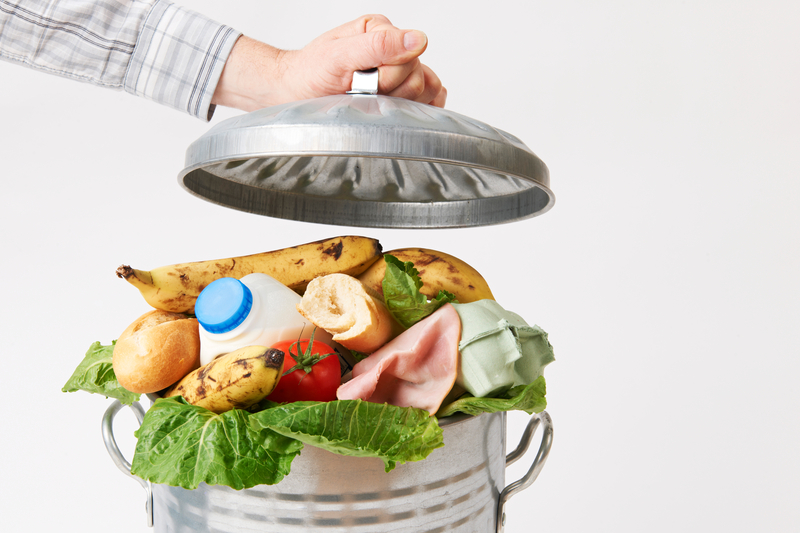15 Easy Ways You Can Help Reduce Food Waste

While over 11% of households or 37.2 million Americans, including 11.2 million children, don’t have enough to eat, according to the USDA (United States Department of Agriculture), up to 40% of food ends up in landfills rather than filling hungry bellies. That’s a waste of over $161 billion in food every year. That waste doesn’t only affect our pocketbooks, it also contributes to greenhouse gasses. In short, there are many reasons to reduce food waste.
Consider this: in the U.S., nearly 70% of our available water and 50% of our land is set aside for agricultural uses. That’s a lot of water and soil to devote to one (highly important) industry. What’s more, the equivalent of nearly 33 million cars’ worth of greenhouse gasses are released to produce food that is destined to just go bad and get tossed.
According to the Environmental Protection Agency (EPA), food is the largest source of trash in the U.S. 1 And about 68% of the food we waste (~42.8 million tons) ends up in landfills or combustion facilities rather than being composted to create healthy soil. 2 Once in the landfills, the rotting food continues to break down, releasing methane, a common greenhouse gas.
That’s a lot of resources and money being wasted—now, and for future generations.
Why Do We Waste So Much Food?
The amount of food wasted has increased by around 50% since the 1970s. This is due in part to the growing portion sizes in the U.S. When we order food, we want to feel like it’s a real value—like we got what we paid for. Restaurants and manufacturers, in turn, have “given us what we want” by expanding menus and buffets, so we fill up our plates with more food than we need.
We’ve become accustomed to seeing store shelves, grocery carts, and fridges overflowing with an abundance of food. And because we can’t eat it all, we have found it acceptable—even positive—to leave food on the plate and then tossed.
We’ve also learned to become pretty picky about the foods we eat and what they look like. A lot of produce isn’t deemed pretty enough to be sold in the supermarket. So, the “ugly” options get tossed or (hopefully) composted to return to the soil.
The most wasted types of foods are vegetables and fruits, followed by dairy products and bread. Then comes meat, which has the largest impact as it takes more land and water resources to produce it.
Fortunately, it isn’t too difficult to change habits to reduce food waste—leading to more money in your pocket, less carbon and methane in the air, and even to help get food into the hands (and bellies) of those who need it.
How to Reduce Food Waste
1. Buy only what you need. If you only need a small amount of a specific fruit or vegetable for a recipe, purchase the smallest package you can find. If you only need a small serving, consider heading to the salad bar section and buying just what you need.
2. Practice portion control. Whether you’re at home or at a restaurant, putting too much food on your plate can not only add up to weight gain, it can also lead to greater food waste. Check in with your hunger before dishing up dinner (or breakfast or lunch) to ensure you don’t overload your plate and end up scrapping much of it into the trash. You can also use this handy portion control method to ensure you get the right amount of food for you.
3. Start with a list. Knowing what you’re going to the store to buy and sticking with only what’s on the list can help ensure you don’t fill your cart up with more food than you can eat in a timely manner.
For example, if you have two apples on the list, don’t purchase a full bag of apples because they’re on sale unless you can plan how you will use them in advance. If you don’t know when or how you’re going to eat the food, leave it in the store. Making a list doesn’t have to be difficult. Here some simple tips to make your grocery trips more efficient and reduce food waste:
- Keep a list of the recipes, meals, or ingredients you regularly use and enjoy.
- Create a list for only the meals you’ll be eating at home: is that one per day? Two? Three? How often do you realistically go out vs. prepare meals at home?
- Keep track of the quantities needed as well as how many meals you’ll make. (For example, salad greens for three lunches.)
- Check your fridge and pantry and “shop” there first. Use the foods you have before buying more. You may even be able to delay going to the store with the foods you already have in your fridge, freezer, and pantry.
- Take a “shelfie” before you shop. That is, take a picture of the foods that are already in your fridge or pantry, so you don’t grab more of something that’s already there.
- Avoid buying in bulk unless you know you’ll actually eat the foods. Bulk purchases don’t save you any money if you end up tossing much of what you buy.
- Store your fresh produce where it’s easy to see and access. And store it appropriately to last longer. (For example, keep bananas, potatoes, and tomatoes on the counter or in the pantry, and keep berries [unwashed], broccoli, and any cut or peeled veggies in the fridge.)
- Freeze or preserve excess vegetables, fruits, and herbs if you won’t be eating them before they go bad. You can also freeze bread and meat.
4. Buy less more often. It’s easy to get ambitious when looking through so many delicious recipes like found on this blog. Instead of deciding you’re going to make all the meals—only to get sidelined by a tough deadline or a rough evening—buy enough food for just the next couple of days rather than a week or more. That way, if you aren’t able to make all of the recipes, you can just push it out to the next night instead of letting the broccoli go bad.
To help reduce food waste, realistically look at your habits. If you often plan to make more food than you actually do, scale back accordingly.
5. Prep your meals. Alternatively, you can buy the food for all of the recipes you’ll be eating, but just get really good at food prep. If you have the foods prepped and ready to go, then no matter how the week goes, you’ll have fresh food that’s ready to cook and eat. Just heat and go and reduce food waste.
This is also exceptionally helpful with snacks. Cut up your vegetables and store them near the front of the fridge for quick, healthy snacks.
You can also make big batches of foods and store them in the freezer for future weeks. For example, batch cook and freeze chicken, taco meat, spaghetti sauce, beans, and more.
6. Make multiple meals with the same ingredients. If your recipe calls for only a small amount of food, choose another recipe for the week that also uses that food. For example, if you have a tomato salad on Tuesday, you can use the rest of the tomatoes in a squash and sauce recipe later in the week.
7. Forget to peel. Many people consider peeling potatoes to be a form of punishment. Lucky for us, there’s no need to peel potatoes, carrots, apples, cucumbers, etc. In fact, the peels are often some of the most nutritious parts of a food—loaded with fiber, vitamins, minerals, and antioxidant phytonutrients. So, if you are just tossing the peels, you’re also tossing money and nutrients.
8. Save the seeds. Whether you’re carving a pumpkin for Halloween or serving up spaghetti squash or acorn squash for dinner, there’s a good chance that you didn’t even consider the seeds before they landed in the trash. Big mistake. These seeds are packed with nutrients like magnesium, they’re easy to roast, and they taste delicious with just a few spices like these Everything Bagel Pumpkin Seeds.
9. Make soup. Another simple way to clear out the remaining vegetables from your crisper is to make soup. Choose a big batch of vegetable or minestrone soup and add any remaining peas, beans, corn, kale, spinach, tomatoes, carrots, celery, and more for a full-flavored, hearty soup.
You can also add many past-their-prime fresh vegetables to rice dishes, casseroles, stir-fries, frittatas, burritos, or smoothies. Blending up stems, peels, and tops (e.g., strawberry tops) is a great way to add extra fiber and nutrients to your smoothies. If a banana is starting to go soft, peel and freeze it to add to smoothies or desserts.
If you have some really dense (or just not all that tasty) veggie offcuts (e.g., big broccoli stalks, celery tops, carrot tops), they can be frozen with other vegetables or even with a roasted chicken carcass or leftover meat bones until you have time to boil them together with water for a nutrient- and flavor-packed homemade stock or broth.
You can even sauté wilted greens (including lettuce) with a touch of butter or oil and some garlic to extend the life of your foods. If it’s still too much food for one meal, toss it into the freezer for a fast meal when you don’t feel much like cooking.
10. Ignore expiration dates. Expiration dates are guidelines rather than rules, and they aren’t well regulated or uniform and are often misunderstood. Best if used by dates indicate when the product will be at its peak, yet foods may still be good long after that date. 3
So, instead of just checking the expiration date, look at the food to ensure it still looks good (color and texture) and smells and tastes okay. If it has gone bad, by all means, get rid of it. You want to avoid food pathogens like salmonella or E. coli. If, however, the food is just slightly limp (with no signs of mold or having gone rancid), it may still be okay for recipes.
11. Don’t be superficial. Fresh fruits and vegetables that aren’t symmetrical, have minor bruising or discolorations, or have other blemishes can still be great to eat (and you may even be able to get them at a discount). So don’t overlook some of the less attractive fresh produce that you’re more likely to find on a farm, at a farmer’s market, or from companies like Misfits Market.
Just make sure the food isn’t moldy, damaged, or rancid. And if you’re buying potatoes, avoid those that are green and growing as they can also come with risks.
12. Plan leftovers. Do you find you tend to toss leftovers every week? Set aside one night a week to eat leftovers or, if you have a family, have a free-for-all night, when you can all pick your favorite foods from the week to clear out any meals that are still remaining. You can also use your leftovers for lunches throughout the week, saving on both food prep and the cost of going out.
13. Declutter your fridge (and pantry). “Out of sight, out of mind” is especially true when it comes to food. Instead of keeping your fridge fully stocked, keep it fully organized. Keep perishable foods upfront and visible, and use the first in, first out rule as you consume foods throughout the week.
Virtually everyone has found a hidden science experiment in the back of the fridge—a food so overgrown with colorful molds that you can’t tell what it was originally. To help prevent this from happening, store leftovers in glass containers in a specific section of the fridge. That way, you know where to look for a quick meal rather than going out and throwing out the food you already have to save both time and money.
14. Follow the two-hour rule. Perishables are safe when left at room temperature for no more than two hours—unless they’re being chilled or kept hot. And if the temperatures rise to above 90-degrees F, put the food away after no more than an hour. Whether you’re at a backyard barbeque or just procrastinating dinner clean up, get any leftovers into the fridge within two hours, so you can safely enjoy them another day. 3
15. Pinpoint your problem. The next time you’re cleaning out the fridge, write down the types of food you’re throwing away and why. Is your milk (cow’s, almond, oat, or hemp) going bad every week? Can you buy or make less? Do you find that you go out (or order in) once or twice a week, yet purchase food to make every night of the week? Do you get pulled in by sales and simply buy more than you and your family can eat? Audit what you regularly throw out, so you can make a new plan.
Reduce Food Waste: A Recap
Reducing food waste saves you money, it reduces resources from getting tossed in landfills, lowers your carbon footprint and prevents pollution (from growing, manufacturing, transporting, and selling foods), conserves energy, and supports a healthy community by providing meals to those who may be struggling right now.
Yet in truth, there will always be some extra food. If possible, instead of just tossing food, donate foods that are safe and untouched to food banks or share excess recipes with friends, family, or neighbors. For example, if you’ve had friends over and prepared an overabundance of foods, pack up containers and send them home with guests. If that doesn’t work, invite over some neighbors for the next day, or pack up care packages to deliver.
For any plant foods that are well past their prime (and can’t even be used in soups, smoothies, or casseroles) along with peelings and offcuts, it’s compost time. If you don’t have room or an outdoor space to compost your own scraps, you can find a countertop composting system. Plus, many cities and organizations have programs to pick up food scraps to compost.
There are so many great reasons to reduce food waste and so many good ways to do so. No one is perfect, but by taking a few extra steps and building on your success, you’ll be rewarded with a fatter wallet, cleaner air, a stronger community, and so much more!






 7 Signs Your Body is Seriously Low on Collagen (not just wrinkles)
7 Signs Your Body is Seriously Low on Collagen (not just wrinkles) Health Expert: "Turmeric Doesn't Work (unless...)"
Health Expert: "Turmeric Doesn't Work (unless...)" 3 Warning Signs Your Probiotic Supplement is a Total Waste
3 Warning Signs Your Probiotic Supplement is a Total Waste

